Choosing a Gaming CPU: Single + Multi-GPU at 1440p, April 2013
by Ian Cutress on May 8, 2013 10:00 AM ESTCivilization V
A game that has plagued my testing over the past twelve months is Civilization V. Being on the older 12.3 Catalyst drivers were somewhat of a nightmare, giving no scaling, and as a result I dropped it from my test suite after only a couple of reviews. With the later drivers used for this review, the situation has improved but only slightly, as you will see below. Civilization V seems to run into a scaling bottleneck very early on, and any additional GPU allocation only causes worse performance.
Our Civilization V testing uses Ryan’s GPU benchmark test all wrapped up in a neat batch file. We test at 1440p, and report the average frame rate of a 5 minute test.
One 7970
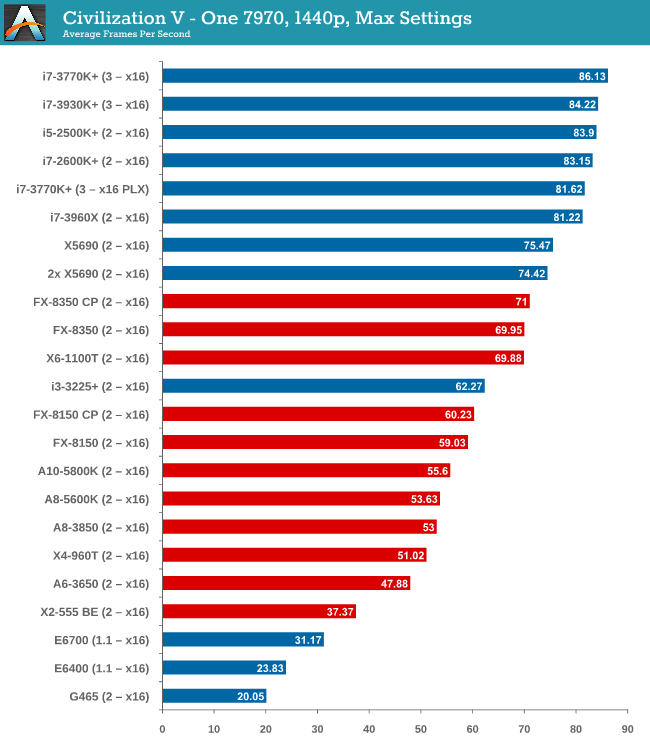
Civilization V is the first game where we see a gap when comparing processor families. A big part of what makes Civ5 perform at the best rates seems to be PCIe 3.0, followed by CPU performance – our PCIe 2.0 Intel processors are a little behind the PCIe 3.0 models. By virtue of not having a PCIe 3.0 AMD motherboard in for testing, the bad rap falls on AMD until PCIe 3.0 becomes part of their main game.
Two 7970s
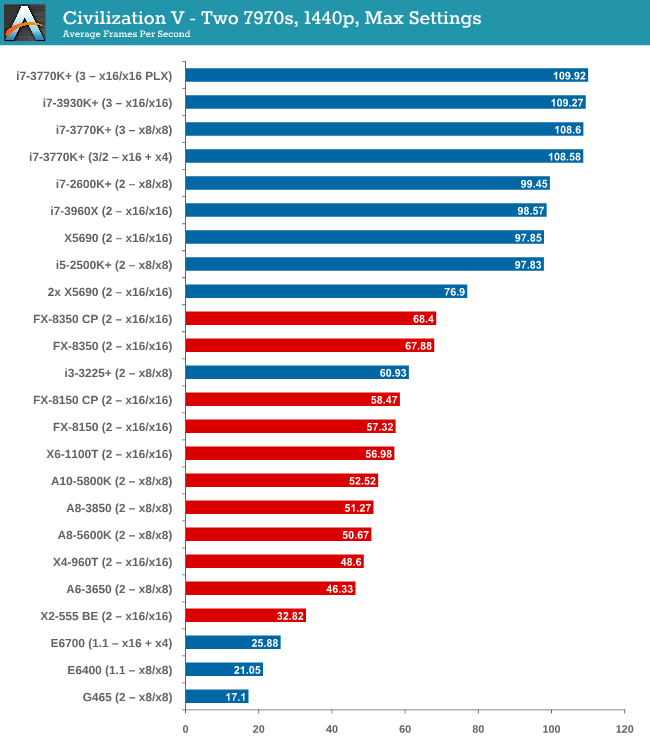
The power of PCIe 3.0 is more apparent with two 7970 GPUs, however it is worth noting that only processors such as the i5-2500K and above have actually improved their performance with the second GPU. Everything else stays relatively similar.
Three 7970s

More cores and PCIe 3.0 are winners here, but no GPU configuration has scaled above two GPUs.
Four 7970s
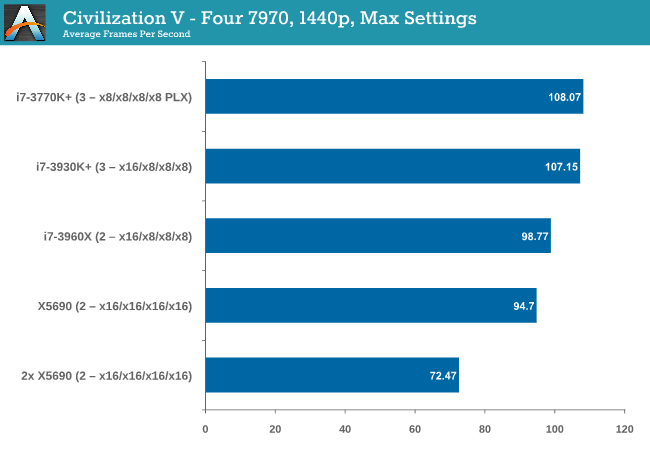
Again, no scaling.
One 580
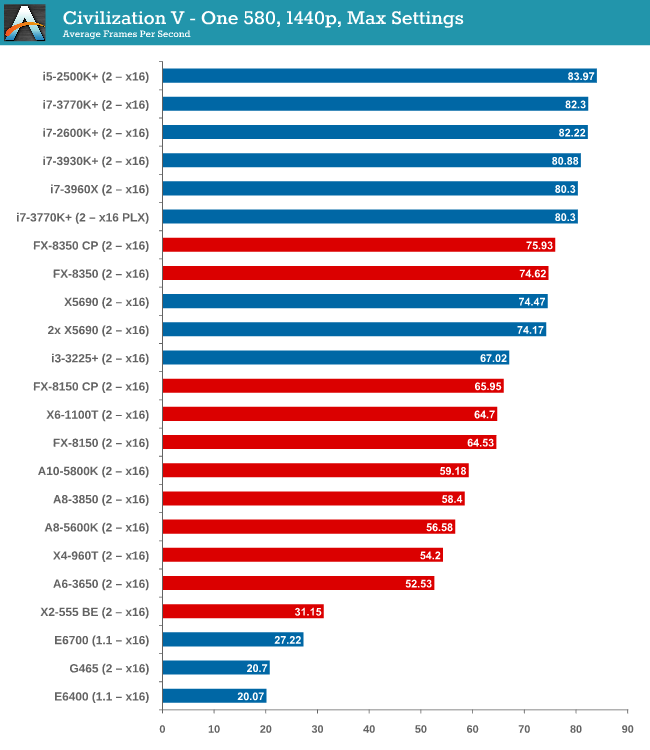
While the top end Intel processors again take the lead, an interesting point is that now we have all PCIe 2.0 values for comparison, the non-hyper threaded 2500K takes the top spot, 10% higher than the FX-8350.
Two 580s
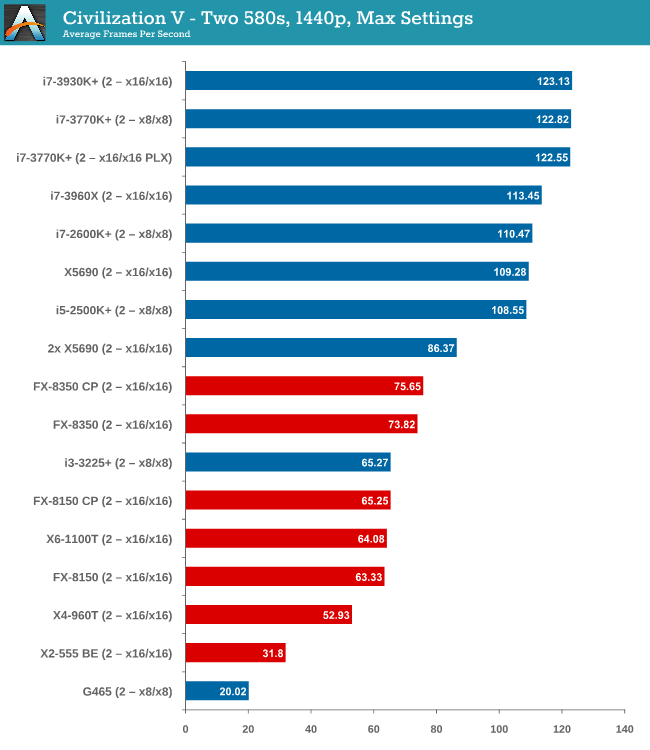
We have another Intel/AMD split, by virtue of the fact that none of the AMD processors scaled above the first GPU. On the Intel side, you need at least an i5-2500K to see scaling, similar to what we saw with the 7970s.
Civilization V conclusion
Intel processors are the clear winner here, though not one stands out over the other. Having PCIe 3.0 seems to be the positive point for Civilization V, but in most cases scaling is still out of the window unless you have a monster machine under your belt.










242 Comments
View All Comments
colonelclaw - Thursday, May 9, 2013 - link
Jarred, I would fully agree with banning any person who continually makes no contribution to the discussion. These comment sections often supply me with useful information, and can be read as a continuation of the article itself. Having to hunt for the valuable opinions amongst piles of cretins and idiots makes me want to go elsewhere.extide - Thursday, May 9, 2013 - link
Please ban him, and I would consider myself a pretty solidly Intel guy myself, but you have to be realistic. Sheesh!Blibbax - Thursday, May 9, 2013 - link
Ban him and anyone else remotely similar.duploxxx - Friday, May 10, 2013 - link
if all would start voting to ban this person there would be a huge amount or thread reply :)Jon Tseng - Wednesday, May 8, 2013 - link
Hmmm. So bottom line is my 2007-vintage QX6850 is perfectly good a 1080p so long as I get the a decent GPU.Bizarro state of affairs when a 6 year old CPU is perfectly happy running cutting edge games. Not sure if I should blame the rise of the GPU or the PS3/XBox360 for holding back gaming engines for so long!
TheInternal - Wednesday, May 8, 2013 - link
In games that are CPU limited (like Skyrim or Arkham Asylum), no. I continue to get the impression from both personal experience and articles/reviews like this that once you have "enough" CPU power, the biggest limiting factor is the GPU. "Enough" often seems to be a dual core operating at 3.0GHz, but newer titles and CPU bound titles continue to raise the bar.Azusis - Wednesday, May 8, 2013 - link
Agreed. Especially in multiplayer situations. Try running PlanetSide 2 or Natural Selection 2 with a core2quad like I do. It isn't pretty. But just about any other singleplayer game... sure, no problem.TheInternal - Wednesday, May 8, 2013 - link
So... these were all tested on a single monitor? Though the article has lots of interesting information, I'd argue that doing these tests on a three monitor 1440p setup would show much more useful information that consumers looking at these setups would be able to apply to their purchasing decisions. It's great to see more reviews on different CPU + multiple GPU configurations, as well as the limitations of such settings, but by limiting such tests to an increasingly unlikely usage scenario of a single monitor, the data becomes somewhat esoteric.Kristian Vättö - Wednesday, May 8, 2013 - link
Did you mean three 1080p monitors (i.e. 5760x1080) by any chance? 7680x1440 is a very, very rare setup especially for a gamer. For work purposes (e.g. graphics designer, video editor etc) it can be justified as the extra screen estate can increase productivity, but I've never seen a gamer with such setup (heck, the monitors alone will cost you close to $2000!). I'm not saying there aren't any but it's an extreme minority and I'm not sure if it's worth it to spend hours, even days, testing something that's completely irrelevant to most of our readers.Furthermore, while I agree that 5760x1080 tests would be useful, keep in mind that Ian already spend months doing this article. The testing time would pretty much double if you added a second monitor configuration as you'd have to run all tests on both configs. Maybe this is something Ian can add later? There is always the trouble of timing as if you start including every possible thing, your article will be waaay outdated when it's ready to be published.
TheInternal - Thursday, May 9, 2013 - link
I didn't mean three 1080p monitors, which does seem to be the "common" three monitor configuration I've seen most gamers going for (since it's cheap to do with 24" panels being under $200 a pop) My 27" S-IPS 2560x1440 panel cost about $300, so I'm not sure where you're getting the $2000 figure from... and if you spend $1500-$2000 on the graphics subsystem, why wouldn't you be spending at least half as much on the monitors?Most modern high-end graphics cards should be able to easily handle three 1080p monitors in a three card config... possibly a two card config... a round up like this would be much more useful to consumers if it did include such information... as well as show just how well the different CPU and GPU combos worked with multiple monitors.